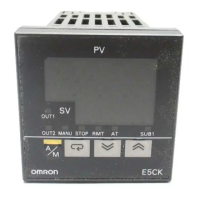CHAPTER 1 INTRODUCTION
E5CK
1–8
1.4 Parameters and Menus
E5CKĆT parameters are distributed between the following ten modes:
Protect mode
Manual mode
Level 0 mode
Program mode
Level 1 mode
Level 2 mode
Setup mode
Expansion mode
Option mode
Calibration mode
The settings of parameters in each of eight modes (excluding the protect
mode and manual mode) can be checked and modified by selection on the
menu display.
The protect function is for preventing unwanted modification of parameĆ
ters, and switching between run and reset operation or auto and manual
operation.
In this mode, the controller can be switched to manual operation. The maĆ
nipulated variable can be manipulated manually only in this mode.
Set the controller to this mode during normal operation. In this mode, you
can change the set point and pattern during operation, and execute step
operation (e.g. advance). You can only monitor (not change) the process
value, step No., standby time, pattern elapsing time, pattern execution
count and manipulated variable.
This is the programming mode. In this mode, you can set the number of
steps used in each pattern, pattern execution count, alarm values, set
points for each step, step time, and time signals for two steps.
This is the main mode for adjusting control. In this mode, you can execute
AT (autoĆtuning), and set up the control period, PID parameters.
This is the auxiliary mode for adjusting control. In this mode, you can set
the parameters for limiting the manipulated variable, switch between the
remote and local modes, and set the loop break alarm (LBA), alarm hysterĆ
esis and the digital filter value of inputs.
This is the mode for setting the basic specifications. In this mode, you can
set parameters that must be checked or set before operation such as the
input type, scaling, output assignments and direct/reverse operation.
JParameter types
F Protect mode
F Manual mode
F Level 0 mode
F Program mode
F Level 1 mode
F Level 2 mode
F Setup mode

